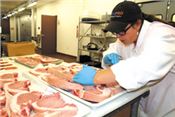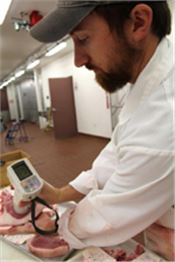|
State Fair Pigs Help MU Researchers Find Balance Of Fat And Flavor
COLUMBIA, MO.
A tender, tasty pork chop begins long before it hits the grill. Students and swine specialists at the University of Missouri Extension study and test meat from State Fair champion pigs. MU Extension, Missouri Department of Agriculture and Missouri Pork Association began the research in 2003.
Research helps pork producers find the right fat-to-lean ratio and flavor to meet consumer demands, says Marcia Shannon, MU Extension swine specialist.
The USDA-approved MU Meat Market processes barrows from the State Fair Growth and Quality Barrow Classic. Producers are paid for the hogs and the meat is sold at the MU Meat Market. Also known as the Don Naumann Muscle Foods Processing Laboratory, the lab supports teaching, extension and research activities of the food science and animal science programs at MU.
MU Meats Judging Team members cut loins from the carcasses and rate them on marbling, color, pH, tenderness and taste. Scores combine with class rankings at the State Fair and performance based upon visual appraisal and growth.
MU’s research shows that paler, leaner cuts lack the tenderness and taste that consumers prefer in darker, more marbled meat.
This is important to pork producers and breeders such as Everett Forkner, the overall winner for the past three years. Forkner, whose family owns Truline Genetics, is a past president of the National Pork Board.
Forkner applauds the MU Extension program for helping producers meet growing customer demands for pork. Truline distributes pork to upscale New Orleans restaurants and some Emeril Lagasse restaurants, as well as to other national and international markets.
Truline uses a 50-50 cross of Berkshire and Duroc hogs. Forkner says the cross is far superior to the individual lines. Berkshire has a natural smoky, sweet flavor with mildly flavored fat that is evenly distributed.
Forkner says Truline's breeding program was in response to the research of MU Extension and Missouri Department of Agriculture.
“Consumer demand is growing for a better-quality product,” he says. “The industry has made great strides in making pork more nutritious and better-tasting.”
Forkner graduated from MU in 1961 with a degree in animal science. During the 1960s, industry specialists moved from shorter, fatter hogs to leaner, more muscular hogs. Since then, research shows that some back fat and marbling better meets consumer demands for flavor and tenderness. Shannon’s rating system helps identify high-end pork throughout the industry.
Forkner says the National Pork Board recently committed to improving color and tenderness quality by 10 percent over the next five years.
Improved customer satisfaction leads to better prices for producers, he says.
Whitney Otto, 21, of Leonard, Mo., took home honors as overall youth winner. She returned to her family's row crop and livestock farm after graduating from Indian Hills Community College in Iowa.
She raises crossbred show hogs on ground. It was her first time to enter the State Fair Growth and Quality Barrow competition, although she has shown livestock in 4-H and FFA. ∆

Katy Shircliff of the MU Meats Judging Team checks pork chops for marbling and color.
MU researchers study factors that determine better taste and tenderness for pork
consumers.
Photo credit: Linda Geist

Research specialist Zach Callahan measures pork for marbling, color and
pH content as part of MU's research to help pork producers meet consumer
demands for tender, tasty pork.
|
|